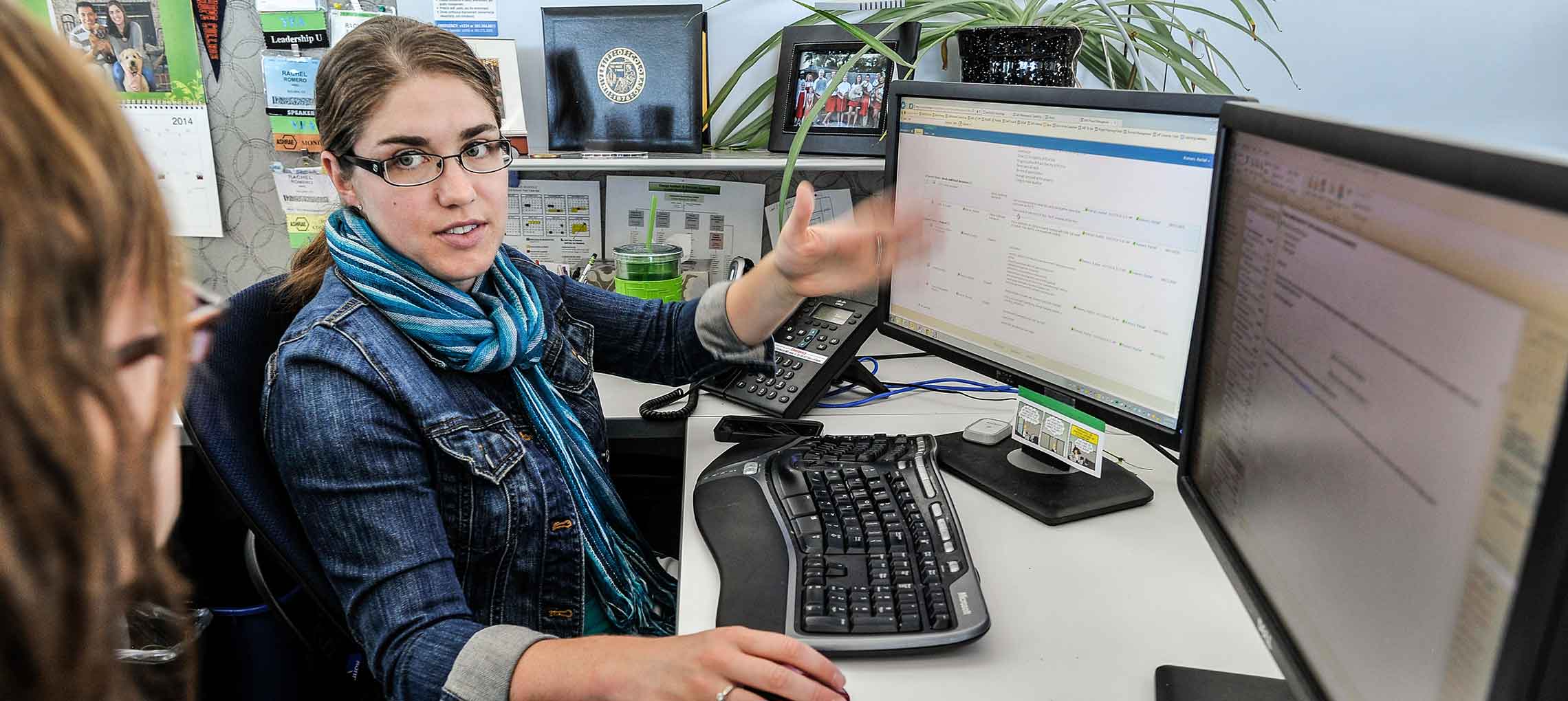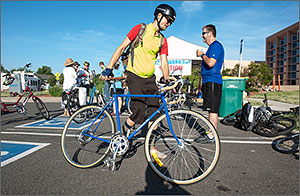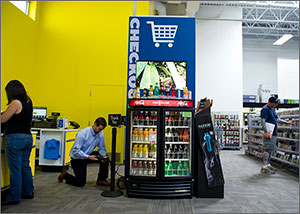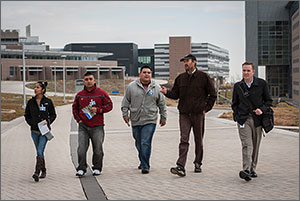NREL's Newest PE-Licensed Engineers Commit to Sustainability

Rachel Romero, one of NREL's new Professional Engineers, devotes much of her time to investigating how federal agencies around the country and the world can save energy. Photo by Dennis Schroeder
The latest class of Professional Engineers (PEs) at the Energy Department's National Renewable Energy Laboratory (NREL) has been around the world, from Alaska to Afghanistan, helping soldiers, airmen, and indigenous peoples save energy while saving taxpayer dollars.
Nationwide, about 20% of engineers earn their PE license, gained only after several years of work under the eyes of a veteran engineer, studying for hundreds of hours, and passing a series of two grueling eight-hour tests.
Last fall, four young engineers at NREL took that second all-day test—four hours on general engineering, a lunch break, and another four hours on their specialty areas. The results came in just before Christmas, and all four passed.
"We completely missed the beautiful Colorado fall," recalled NREL's Colton Heaps, 33, of the seven consecutive Saturdays the aspirants for the PE license spent at all-day review courses in preparation for the October 24 test.
The test was open book, and there was no limit to how many books they could open. Rachel Romero, 28, a mechanical engineer at NREL, rolled in a cart full of books. "Some people brought in books on dollies," said Lars Lisell, 29, also an NREL mechanical engineer. "I just had five."
Heaps brought only as many books as he could comfortably fit in his backpack. "I figured if I needed more than a backpack of books, they were just going to be a burden," Heaps said. NREL's Michael Sheppy, 29, echoed that sentiment: "The more books you bring, the more time you end up wasting by riffling through them."
Romero has a master's degree in mechanical engineering, but said the PE license "is a nationwide-accepted demonstration of the caliber of engineer I am." As her mentor, NREL Professional Engineer Sheila Hayter told her: "With the PE license, you have clout immediately once you walk into a room. Others automatically accept you as having a certain level of knowledge."
Heaps, Lisell, and Sheppy all prepared for the PE test under the mentorship of NREL Senior Engineer Otto Van Geet, and agree he was a great mentor.
The PE license is required to sign off on engineering designs, but it also helps ensure that the candidates who work for years under the watch of veteran engineers develop the thoroughness and ethics essential for the profession. At NREL, engineers don't sign off on designs, because that's a task for the private sector, with which national labs do not compete. For Lisell and Sheppy, obtaining the PE license was important for the trustworthiness it conveys. "Having people recognize that I am a competent engineer is important to me," Lisell said. "Especially as a 29-year-old, working with more experienced people—it lends credibility to things that I am recommending."
"I would want to be represented in court by a lawyer who passed the bar," Sheppy said. "I look at the PE license as passing the bar." All four newly licensed NREL engineers agree that the mentorship of more senior engineers and the support that NREL provides in the process are invaluable.
Lessons Learned on the (Sustainable) Farm
Whether nudging his house toward net-zero energy or restoring 50-year-old motorcycles, Lars Lisell applies the work ethic and passion for sustainability that he nurtured on his parents' chilly organic farm in far northern Minnesota.
Lisell works in deployment at NREL, helping federal agencies and private firms make dramatic cuts in their energy use. "We're helping to move the markets to a more sustainable place," Lisell said. "A lot of our clients are government agencies, and it's a real win-win. We're helping them become more sustainable, and at the same time we're saving them dollars—and saving taxpayer dollars."
Lisell is NREL's point man on moving Fort Hunter-Liggett in California's Salinas Valley toward its goal of net-zero energy by 2020. "They're on track to get there," he said, listing large solar installations, energy efficiencies, and a waste-to-energy project as three ways the training facility will reach the goal.
He also was instrumental in NREL's simuwatt Energy Auditor project, a way to conduct inexpensive, thorough audits of buildings that has been shown to help cut energy use significantly. The NREL innovation has been licensed to Concepts3D, which is close to launching its initial widespread blitz.
Lisell grew up in Roseau, Minnesota, 10 miles south of the Canadian border, where he stacked hay bales on the organic farm when he wasn't helping harvest wheat, barley, oats, canola, soybeans, and flax.
"I always had a broad interest in sustainability," he said. "I guess it was growing up on the farm, with a real close connection to the land."
Lisell enrolled in the engineering school at the University of Minnesota, specializing in mechanical engineering, and taking whatever classes he could find that related to renewable energy. He said his interest in heating and air conditioning systems "just kind of came out of my more broad interest in sustainability."
Lisell Aiming for a Net-Zero Home
 Enlarge image
Enlarge image
Lars Lisell, newly minted Professional Engineer at NREL, walks (and pedals) the talk,
often riding his bike or old motorcycles rather than driving his car. Here, he is
finishing up NREL's Bike to Work Day.
Photo by Dennis Schroeder
Lisell's commitment to sustainability doesn't end when his workday is done. He and his wife live in a 1920s-era brick bungalow in Denver, and are working their way toward a net-zero-energy home in a housing style that is infamous for its leakiness.
They bought the house three years ago, and already have lowered their electricity bill to zero and have slashed about 70% off the heating bill.
Just like in his professional work, he looked at energy efficiency first. "When we moved in, the house was an energy hog," Lisell said. "We put in insulation, a smart thermostat, did air-sealing on the rim joists and in the attic, insulated all the hot water pipes, flushed the water heater, and switched out all the lights to LEDs and compact fluorescents."
After six months of efficiency work, Lisell installed solar panels. He also rewired the house so it is ready for the ground-source heat pump he hopes to install this summer. "You're using the ground as a big heat sink," Lisell explained. "During the summer, you're pumping heat out of your house into the ground; in winter, you pump heat out of the ground and into the house. And it provides hot water, too." If it works, his house could be carbon neutral by Labor Day.
Romero a Champion of Sustainability by All
Rachel Romero credits her interest in mechanical engineering to a high school physics teacher pointing her toward an engineering camp at the University of Colorado. "I saw the experiments and knew right away that engineering is what I wanted to do. I liked science and math, but didn't want to do just that. I'm more of an executor than a researcher. I like to get things done; I like to see things get built."
Romero was a championship-caliber freestyler on the swimming team at Hope College in Michigan. Her affinity for water shows up in her NREL work for the U.S. Coast Guard, in places such as Kodiak, Alaska, helping with the service's energy management program. The long-term goal is to switch Coast Guard bases away from almost total reliance on fuel-oil burners to reliance on renewable energy for heat, light, and electricity.
"I love my clients; I love my work," said Romero, who also helps the U.S. Department of Homeland Security with the logistics of adding, say, solar panels to regional airports.
"What really drives me is trying to push people to practice energy efficiency," Romero said. "I'm a very practical person. I won't just say that it can help save the planet, I will tell them to change out a light bulb because it will last longer and save them money in the long run." When talking about rooftop solar, she'll remind her clients: "We're not going to have fossil fuels forever." She'll use gentle persuasion, suggesting that a data center doesn't have to operate at extreme temperatures all day. "Everyone in society has an opportunity to help out and solve these problems," Romero said.
When not working, Romero trains for sprint triathlons, at which she typically gets a huge lead in the swimming portion and tries to hold off the competition in the bicycling and running legs.
At home, she, her husband, and their two dogs live comfortably under the auspices of their Nest thermostat that can turn the temperature up or down automatically or at the touch of a button from a smart phone. "We even get an energy report on how we're doing compared to other Nest users. It gets my competitive juices going."
Sheppy Helps the Navy Save Energy and Dollars
 Enlarge image
Enlarge image
Michael Sheppy, another of NREL's newly minted Professional Engineers, measures plug
loads and verifies lighting measurements at the Best Buy Store in Lakewood, Colorado.
Best Buy participated in NREL's Commercial Building Partnerships program as a way
to lower its energy bills.
Photo by Dennis Schroeder
Michael Sheppy, who works with Sustainable NREL, traces his interest in mechanical engineering to growing up in Riverside, California, a city often listed as having the worst air pollution in the United States. "The smog from Los Angeles blows southeast down to Riverside, which is like a big canyon trapping the air around the city," Sheppy said. "We were always having our gym classes canceled because of the poor air quality. That motivated me to get involved in saving the environment."
At the University of California, Riverside, he interned at the Mobile Diesel Laboratory—"a lab inside a semi-truck container"—seeing firsthand which types of diesel fuel produced the most pollution. After earning his bachelor's degree, he worked at a wind farm in Palm Springs, California, watching the production of renewable energy. "It was eye-opening, and it solidified my interest in an engineering career."
A highlight for Sheppy has been his work with the U.S. Naval Facilities Engineering Command (NAVFAC) demonstrating the effectiveness of advanced power strips in a small office building. "It was satisfying to measure and verify significant energy savings—8% of the whole building's energy consumption—and to see NAVFAC adopt the technology in other buildings. When a project you're working on results in real energy savings, it's very rewarding."
Sheppy, who has a master's degree in mechanical engineering from the University of California, Berkeley, doesn't ignore energy savings at home. He has 3.28 kilowatts of photovoltaics (PV) on his rooftop, and he and his wife keep a careful eye on how much energy they consume versus how much the PV array produces.
Heaps Brings Engineering and Public Policy Degrees to Bear
Colton Heaps came to NREL three years ago after earning his bachelor's degree in mechanical engineering at the U.S. Air Force Academy and serving several years in the Air Force. While in the Air Force, he earned a master's in public policy at the Kennedy School of Government at Harvard University and worked on sustainability for bases in the Middle East.
Heaps found his public policy degree was nearly as valuable as his engineering degree when making the argument in favor of energy sustainability.
He brings engineering experience but also financial analysis to projects "to make sure they're viable and justified by the economics."
"It's not enough to tell the base leaders that making changes will save energy," Heaps said. The mission comes first in the military, so officers are reluctant to cut corners when it comes to the effectiveness of their tactics and strategy, he said. So, he makes the argument that saving energy will give them the leeway to make their military capability even stronger.
"It has the potential to save them a lot of money, as well as saving a lot of money for the U.S. taxpayer," Heaps said. Most crucially, every efficiency improvement means fewer dangerous truck rides to deliver diesel fuel to military bases in war-torn regions. "There's a real human cost to that," Heaps said, noting the high fatality rate among drivers hauling diesel fuel to bases. "Every gallon that's saved … well, it's impossible to monetize the benefit."
In a recent project, Heaps helped a small village in Alaska that wanted to put in a biomass wood boiler to heat several buildings; he provided feedback on the design and an analysis of the finances. Heaps also manages the Strategic Technical Assistance Response Team (START) program at NREL that works with the Office of Indian Energy to help bring sustainable energy projects to Native American communities. For example, the San Carlos Apaches in Arizona hope to erect a megawatt of PV panels to help power their casino and resort complex.
 Enlarge image
Enlarge image
Colton Heaps, far right, one of NREL's new Professional Engineers, walks with his
mentor, Otto Van Geet, nearest to him, and three members of the Zuni Pueblo tribe
touring NREL to learn about potential energy savings on their tribal lands (from left,
Reyna Banteah, Shaun Tsabetsaye, and Jeremy Luselute).
Photo by Dennis Schroeder
In Kuwait, the power for U.S. military bases is supplied by the Kuwaiti government, so the incentives aren't strong to save energy. The problem is compounded because the energy demand is modest in the winter when the temperatures hover in the 50s and 60s, but enormous in the summer when air conditioning needs to be cranked up to counter ambient temperatures that can reach 130°F, and the humidity can fluctuate from 10% to 90%. Still, using his engineering and public policy strengths, Heaps has made headway.
Essential Work—and America Can Lead
"I think we're doing important work," Heaps said. "Energy efficiency and renewable energy are so important, and we can't avoid the reality any longer. The infrastructure in the United States and in the rest of the world is growing at such a pace that our sources of traditional energy just can't keep up with it. Global warming aside, we're going to have to have to do things more efficiently and find alternative sources of energy. And then when you throw in the whole climate change debate, it just becomes much more of an imperative that we get serious about this problem we face."
The United States, Heaps said, "has a real opportunity to lead on that front, to forge the way ahead for a new energy economy for the world."
Learn more about NREL's buildings research.
— Bill Scanlon
Last Updated May 28, 2025
